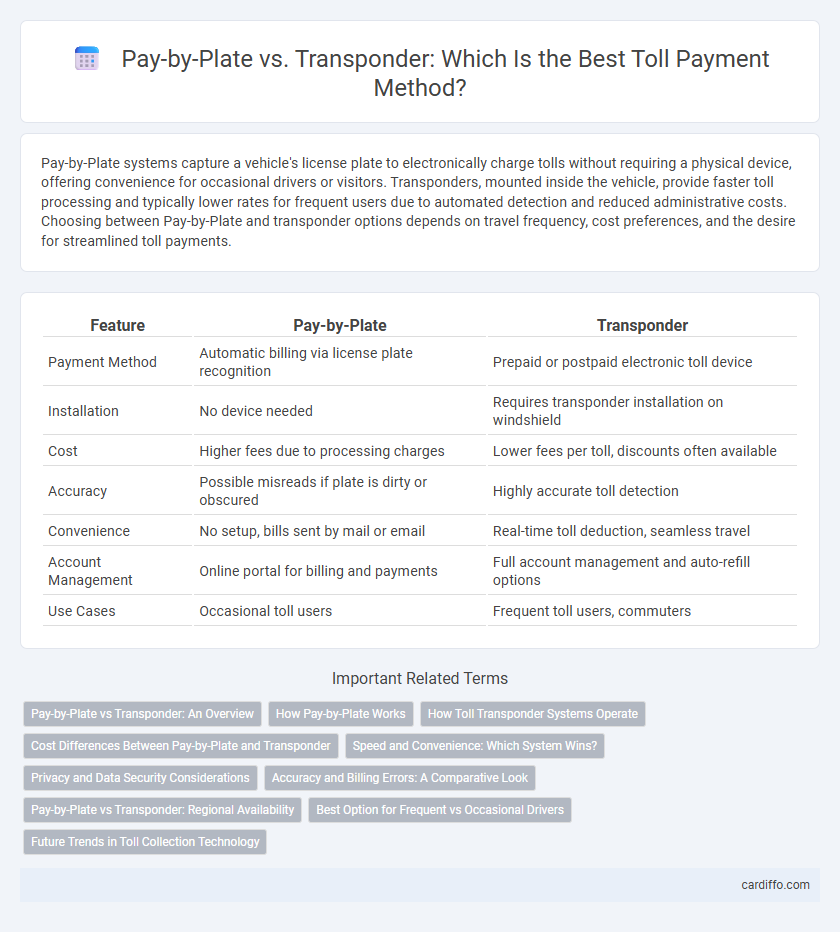Pay-by-Plate systems capture a vehicle's license plate to electronically charge tolls without requiring a physical device, offering convenience for occasional drivers or visitors. Transponders, mounted inside the vehicle, provide faster toll processing and typically lower rates for frequent users due to automated detection and reduced administrative costs. Choosing between Pay-by-Plate and transponder options depends on travel frequency, cost preferences, and the desire for streamlined toll payments.
Table of Comparison
| Feature | Pay-by-Plate | Transponder |
|---|---|---|
| Payment Method | Automatic billing via license plate recognition | Prepaid or postpaid electronic toll device |
| Installation | No device needed | Requires transponder installation on windshield |
| Cost | Higher fees due to processing charges | Lower fees per toll, discounts often available |
| Accuracy | Possible misreads if plate is dirty or obscured | Highly accurate toll detection |
| Convenience | No setup, bills sent by mail or email | Real-time toll deduction, seamless travel |
| Account Management | Online portal for billing and payments | Full account management and auto-refill options |
| Use Cases | Occasional toll users | Frequent toll users, commuters |
Pay-by-Plate vs Transponder: An Overview
Pay-by-Plate tolling uses automatic license plate recognition to charge drivers without a transponder, offering convenience but potentially higher fees due to processing costs. Transponders, like E-ZPass, provide faster, discounted toll payments through wireless communication with toll gantries and reduce violations. Choosing between Pay-by-Plate and transponders depends on travel frequency, cost sensitivity, and convenience preferences.
How Pay-by-Plate Works
Pay-by-Plate systems use license plate recognition technology to capture vehicle plates at toll points, automatically recording toll charges without requiring physical transponders. Cameras installed at toll booths or gantries photograph license plates, and the system cross-references the plate number with a pre-registered payment account or sends a toll invoice by mail. This method offers a convenient, contactless toll payment option, especially for infrequent users or vehicles without transponders.
How Toll Transponder Systems Operate
Toll transponder systems operate by using radio-frequency identification (RFID) technology to communicate between the vehicle's transponder and toll plaza readers, automatically deducting toll fees from a prepaid account. These systems provide seamless, high-speed lane access without requiring drivers to stop, significantly reducing traffic congestion. Unlike pay-by-plate methods that rely on license plate imaging and subsequent billing, transponders offer real-time transaction processing and lower operational costs.
Cost Differences Between Pay-by-Plate and Transponder
Pay-by-Plate toll systems typically incur higher fees compared to transponder-based tolls due to additional processing and administrative costs associated with license plate recognition. Transponder users benefit from discounted toll rates and reduced billing overhead, leading to overall cost savings for frequent travelers. Choosing a transponder can significantly lower expenses, especially on toll roads with tiered pricing structures favoring electronic pass holders.
Speed and Convenience: Which System Wins?
Pay-by-Plate systems delay toll processing due to image capture and license plate recognition, while transponders offer instant electronic toll collection, significantly increasing speed at toll points. Transponders provide greater convenience by automatically deducting tolls without requiring vehicles to slow down or stop, reducing traffic congestion and improving commute times. The seamless integration of transponder technology with various toll networks further enhances user experience compared to the slower, manual review often associated with pay-by-plate systems.
Privacy and Data Security Considerations
Pay-by-Plate toll systems capture and store license plate images linked to vehicle and owner information, raising concerns about unauthorized access and long-term data retention. Transponder-based systems transmit encrypted identifiers with limited personal data exposure, reducing risks of surveillance and data breaches. Choosing a transponder enhances privacy protection through controlled data flow and secure authentication protocols.
Accuracy and Billing Errors: A Comparative Look
Pay-by-Plate toll systems rely on automated license plate recognition, often leading to higher rates of billing errors due to misreads or poor image quality, whereas transponder-based systems, using RFID technology, deliver more accurate toll recording and fewer disputes. Studies show transponders reduce billing inaccuracies by up to 90%, improving overall customer satisfaction and streamlining toll enforcement. Toll operators benefit from decreased administrative costs and enhanced revenue assurance with transponder usage compared to pay-by-plate methods.
Pay-by-Plate vs Transponder: Regional Availability
Pay-by-Plate toll systems are widely available across various regions, including many urban areas and statewide highway networks, offering convenience where transponder use is less common. Transponder-based tolling remains predominant in regions with established electronic toll collection infrastructure, such as Florida, Texas, and California, providing faster processing and discounted rates for users. Regional availability depends on local transportation authority policies, with some areas exclusively supporting transponders while others integrate both systems for greater flexibility.
Best Option for Frequent vs Occasional Drivers
Frequent drivers benefit most from transponders due to seamless toll processing, discounts, and reduced wait times, enhancing travel efficiency. Occasional drivers may find pay-by-plate systems more convenient, avoiding upfront transponder costs and maintenance but potentially incurring higher toll rates and billing fees. Evaluating travel frequency and cost-effectiveness helps determine the optimal toll payment method.
Future Trends in Toll Collection Technology
Future trends in toll collection technology emphasize seamless integration of Pay-by-Plate systems with advanced AI-driven license plate recognition, enhancing accuracy and reducing processing time. Transponder technology is evolving with increased interoperability across multiple toll networks and incorporation of 5G connectivity for real-time data transmission. Innovations also include hybrid models combining transponders with mobile app-based payments to cater to diverse driver preferences and improve overall toll system efficiency.
Pay-by-Plate vs Transponder Infographic

 cardiffo.com
cardiffo.com